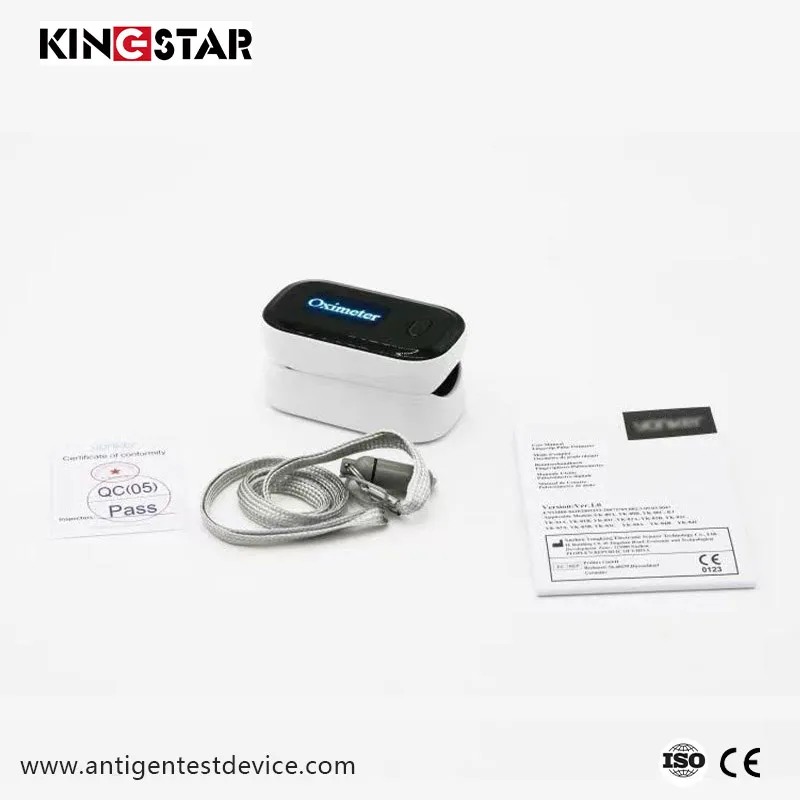What Factors Affect Pulse Oximeter Readings?
2024-10-14
Pulse oximeters have become essential tools in both healthcare settings and home environments, especially in recent years due to their role in monitoring blood oxygen levels. These compact devices measure oxygen saturation (SpO2) and pulse rate, providing valuable information about respiratory and cardiovascular health. However, despite their usefulness, pulse oximeter readings can be influenced by various factors, sometimes leading to inaccurate results. In this blog, we'll explore the key factors that affect fingertip pulse oximeter readings and how you can ensure accurate measurements.

1. Proper Placement and Fit
The most basic yet crucial factor that affects the accuracy of pulse oximeter readings is how the device is placed on your body. Typically, a pulse oximeter is clipped onto a fingertip or earlobe, where it shines light through the skin to measure blood oxygen levels. For accurate readings:
- Proper Fit: Ensure the oximeter fits snugly, but not too tightly, on your finger or earlobe. A loose fit may allow external light to interfere with the sensor, while a fit that's too tight can constrict blood flow, affecting the reading.
- Finger Selection: The pulse oximeter works best when used on warm, healthy fingers. Poor circulation in certain fingers, such as the thumb or pinky, can lead to inaccurate readings. For most people, the index or middle finger on the hand will provide the most accurate results.
2. Nail Polish or Artificial Nails
One of the most common factors that interfere with pulse oximeter readings is the presence of nail polish or artificial nails. Dark-colored nail polishes, such as red, black, or blue, can block or absorb the light emitted by the oximeter, preventing it from accurately measuring blood oxygen levels. Artificial nails can also obstruct the light sensor.
To ensure accurate readings:
- Remove dark nail polish or opt for clear or light colors.
- If wearing artificial nails, consider using the oximeter on an unadorned finger or earlobe instead.
3. Skin Pigmentation
Skin pigmentation can also impact the accuracy of pulse oximeter readings. Research has shown that in some cases, people with darker skin tones may receive slightly higher oxygen saturation readings than their actual levels. This is because the melanin in the skin can absorb the light used by the pulse oximeter, causing a potential miscalculation.
While the effect is generally minor, it's important to be aware of this potential bias. If you have darker skin and rely on pulse oximeter readings to monitor health conditions, it's a good idea to pair readings with other signs of oxygen deprivation, such as shortness of breath or changes in skin tone.
4. Motion and Movement
Pulse oximeters require steady positioning to obtain an accurate reading. Movement—whether you're fidgeting, adjusting the device, or if your hands are shaking—can cause false readings or lead to fluctuations in the numbers displayed.
To get a reliable measurement:
- Remain still while the pulse oximeter is working.
- Avoid talking or moving the hand that the oximeter is attached to during the reading process.
For people who experience tremors or difficulty keeping still, consider using an oximeter designed to compensate for motion or choosing a different body part, such as the earlobe, which is less prone to movement.
5. Poor Circulation or Cold Hands
Pulse oximeters rely on detecting blood flow to measure oxygen saturation. When your hands are cold, or if you have poor circulation due to conditions like Raynaud’s disease, peripheral artery disease, or even temporary cold exposure, the blood vessels in your extremities can constrict. This restricts blood flow and can result in the oximeter not picking up a clear signal, leading to inaccurate or fluctuating readings.
To improve accuracy:
- Warm your hands before using the oximeter by rubbing them together or running them under warm water.
- If you suffer from chronic poor circulation, consider testing the oximeter on your earlobe, which typically has better blood flow than the fingers.
6. External Light Interference
Pulse oximeters work by emitting light through the skin and detecting how much light is absorbed by oxygenated and deoxygenated blood. External light sources, such as sunlight, fluorescent lights, or other strong lighting, can interfere with this process, leading to inaccurate readings.
For accurate results:
- Use the pulse oximeter in a well-lit but controlled environment, away from direct sunlight or bright overhead lights.
- Shield the oximeter with your other hand or a cloth to block excess light if necessary.
7. Carbon Monoxide Poisoning
Pulse oximeters measure the percentage of oxygen saturation in the blood, but they cannot differentiate between oxygen and other gases, such as carbon monoxide. When carbon monoxide binds to hemoglobin, it gives the same light absorption signals as oxygen, potentially leading to falsely elevated oxygen saturation readings.
This is particularly concerning in cases of carbon monoxide poisoning, where a pulse oximeter may give a misleadingly high oxygen level despite the body being starved of oxygen. If carbon monoxide poisoning is suspected, it's crucial to seek medical attention immediately, as pulse oximeters alone cannot detect the presence of this dangerous gas.
8. Low Oxygen Levels
When oxygen levels fall below a certain threshold (generally below 80% SpO2), pulse oximeters may struggle to provide an accurate reading. This is because very low oxygen saturation affects how well the device can detect the light signals, causing the readings to become erratic or unreliable.
In situations where SpO2 is very low, it’s important to confirm pulse oximeter readings with medical testing or equipment, such as arterial blood gas analysis, which can provide a more accurate assessment of blood oxygen levels.
9. Hemoglobin Levels and Blood Disorders
Certain medical conditions can also affect pulse oximeter readings. People with anemia, where there is a lower-than-normal number of red blood cells, may show artificially low oxygen saturation readings. Similarly, conditions like sickle cell anemia or other blood disorders can affect how the pulse oximeter interprets the oxygen-carrying capacity of hemoglobin.
If you have a known blood disorder, it's important to monitor your pulse oximeter readings closely and consult with a healthcare provider to ensure you’re interpreting them correctly.
10. Altitude
High altitudes can also impact pulse oximeter readings. At higher elevations, the oxygen levels in the air are lower, which naturally lowers blood oxygen saturation levels. This is a normal physiological response, but people living in or traveling to high-altitude areas should be aware that SpO2 readings might appear lower than usual.
For those monitoring oxygen levels at high altitudes, it's essential to understand the baseline saturation for the area and recognize that slight decreases in SpO2 are common and not always cause for concern.
Pulse oximeters are useful tools for monitoring oxygen levels, but their accuracy can be influenced by several factors, from proper placement and movement to skin tone and medical conditions. By understanding the variables that can affect pulse oximeter readings, you can take steps to improve the accuracy of your results.
For most accurate readings, ensure the device is placed correctly, avoid nail polish or artificial nails, keep hands warm, and remain still during measurement. If you're concerned about the accuracy of your readings, especially in the context of a medical condition, consult with a healthcare professional for further evaluation and advice.
KINGSTAR INC is a large reliable and professional manufacturers and suppliers for face mask, simple operation covid-19 self test rapid antigen test, covid-19 self test rapid antigen test. We are very famous in China. Find detailed product information on our website at https://www.antigentestdevices.com/. Should you have any inquiries, don't hesitate to contact us at info@nbkingstar.com.



